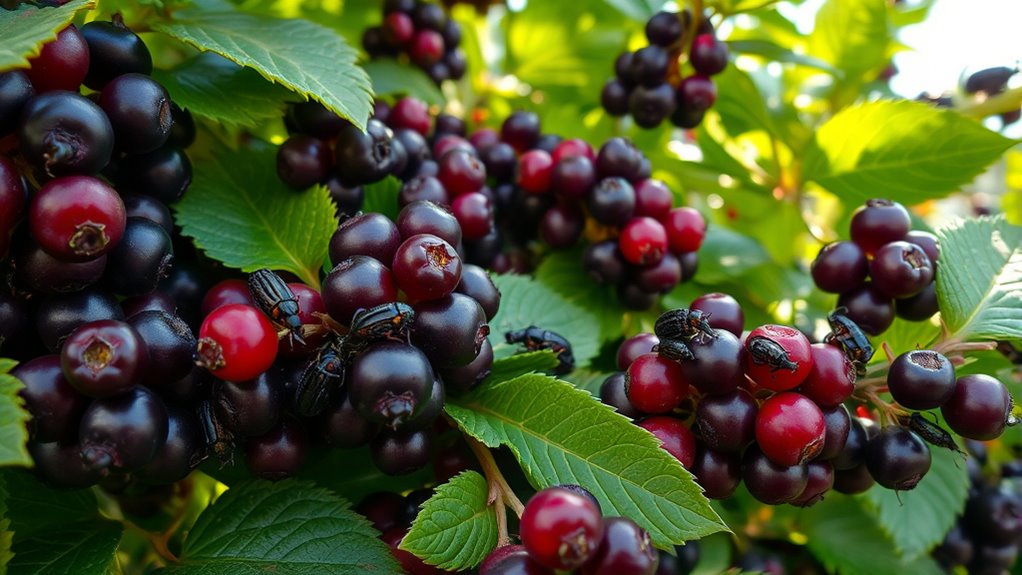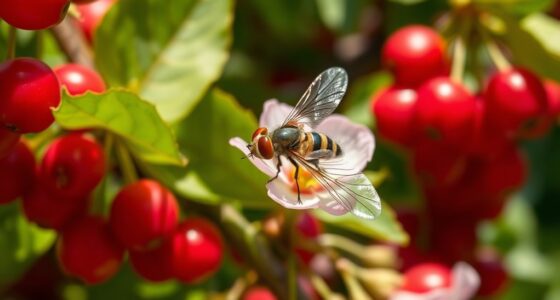If you notice notched leaves, wilting plants, or dying roots in your berry patch, root weevils might be to blame. These pests hide in soil, feeding on roots and bark, often without obvious signs. To manage them organically, encourage natural predators like beneficial nematodes, use mulches to block egg-laying, and inspect regularly. Combining control methods can help protect your berries; explore more tips to keep these pests at bay.
Key Takeaways
- Look for notched leaves, wilting, and plant dieback as signs of root weevil damage in berry patches.
- Use organic mulches and row covers to physically block adult weevils from laying eggs.
- Apply beneficial nematodes in early spring or late fall to naturally control larvae populations.
- Remove fallen debris, weeds, and infested plant material regularly to reduce weevil habitats.
- Combine biological, cultural, and physical controls like neem oil, mulching, and proper spacing for integrated pest management.

If you’re growing berries, you’ve probably noticed that root weevils can pose a serious threat to your plants. These pests are small, dark beetles that feed on the roots and bark of berry plants, causing damage that can stunt growth or even kill your crop if left unchecked. Managing root weevils effectively requires a strategic approach to pest management, especially if you prefer organic controls. You need to be vigilant, inspecting your plants regularly for signs of infestation, such as notched leaf edges or the presence of adults and larvae around the base of your bushes.
Since chemical controls may not align with your organic gardening goals, using organic pest management techniques is vital. One of the most effective methods is to encourage natural predators like nematodes, which specifically target weevil larvae in the soil. Applying beneficial nematodes in early spring or late fall creates a biological barrier that reduces larval populations without harming beneficial insects or your soil’s health. Additionally, you can incorporate organic mulches around your berry plants. Mulching helps to suppress adult weevils from laying eggs by creating a physical barrier and maintaining soil moisture, which discourages pest activity.
Encourage nematodes and mulch to naturally control root weevils and protect your berry plants organically.
Another key component of organic controls involves cultural practices. Regularly removing fallen leaves, plant debris, and weeds from around your berry patch reduces potential hiding spots for adult weevils. Avoid overwatering, as moist soil can attract weevils, and ensure proper spacing to improve air circulation, which makes your plants less hospitable to pests. You might also consider using row covers during the growing season. These lightweight fabrics act as physical barriers, preventing adult weevils from accessing your plants to lay eggs.
If you notice signs of infestation, such as wilting or dieback at the base of your plants, it’s vital to act promptly. Applying organic insecticidal sprays derived from neem oil or insecticidal soap can help manage adult weevils. These treatments are most effective when applied in the evening when pests are active and before egg-laying occurs. Incorporating integrated pest management strategies ensures a comprehensive approach to controlling root weevils while maintaining the health of your organic garden. Remember, combining multiple organic controls—biological, cultural, and physical—creates a complete pest management strategy that keeps root weevils at bay while maintaining the integrity of your organic garden.
Frequently Asked Questions
Are Root Weevils Harmful to Other Garden Plants?
Yes, root weevils can be harmful to other garden plants as well as berry patches. They are a common garden pest that causes plant damage by feeding on roots and stems, which weakens and sometimes kills plants. If you notice signs of root weevils, like notched leaves or wilting plants, it’s important to act quickly to control them and prevent further damage to your garden.
What Natural Predators Control Root Weevil Populations?
Imagine a garden under a natural ballet, where beneficial insects dance to keep pests in check. Predatory beetles, parasitic nematodes, and certain birds actively hunt root weevils, controlling their numbers. By promoting predator management, you encourage these natural predators to thrive. To support them, avoid chemical pesticides and plant a diverse range of flowering plants, creating a thriving ecosystem where beneficial insects flourish and root weevil populations decline naturally.
Can Root Weevils Affect Berry Crop Yields Significantly?
Yes, root weevils can considerably affect your berry crop yields. They damage plant roots, leading to stunted growth and reduced fruit production. To combat this, you should consider companion planting with herbs like garlic or marigolds, which repel weevils, and practice crop rotation to break their life cycle. These strategies help protect your berries, ensuring healthier plants and better yields throughout the season.
How Do Weather Conditions Influence Root Weevil Activity?
Ever wondered how weather shapes the havoc in your berry patch? You’ll find that soil moisture and temperature fluctuations play a big role. Warm, moist conditions invite root weevils to become more active, increasing their damage. Conversely, cooler or drier weather can slow them down. So, keeping an eye on weather patterns helps you anticipate and manage weevil activity, protecting your crop from their destructive habits.
Are There Organic Methods to Prevent Root Weevil Infestations?
Yes, you can prevent root weevil infestations organically. You should introduce beneficial nematodes into your soil, as they naturally target and control weevil larvae. Additionally, applying organic repellents like neem oil or diatomaceous earth around your berry plants can deter adult weevils. Regularly inspect your patch and maintain healthy soil to make your environment less inviting for these pests, ensuring a more organic and sustainable approach.
Conclusion
Now, picture the vibrant green leaves of your berry patch, trembling gently as root weevils creep beneath the surface. Their tiny, dark bodies hide among the roots, quietly causing damage that you might not see right away. Stay vigilant, inspect regularly, and act swiftly. With your careful attention, you can protect your berries from these hidden invaders, ensuring your patch flourishes and rewards your efforts with lush, juicy fruit that’s worth every moment you spend guarding it.









